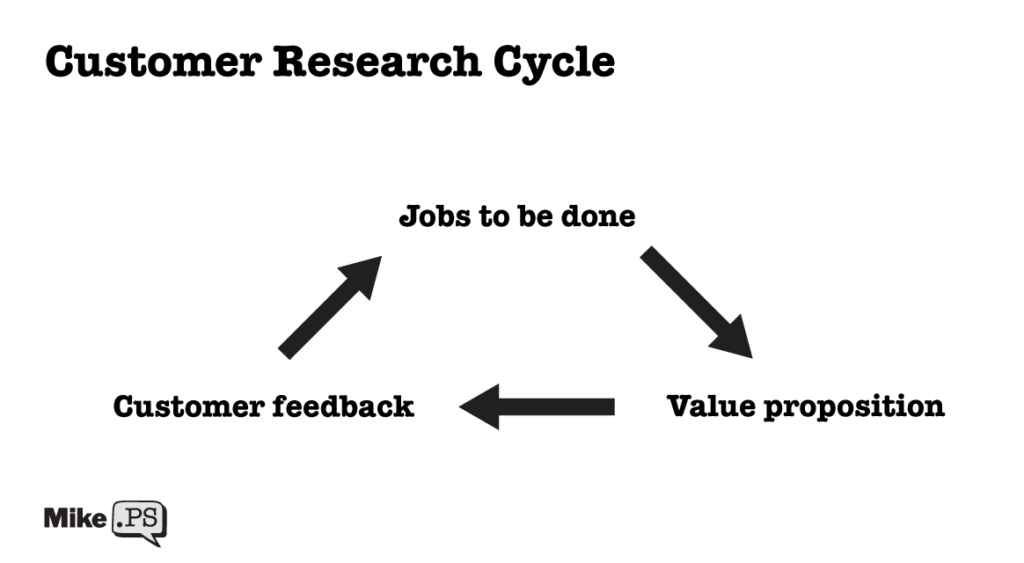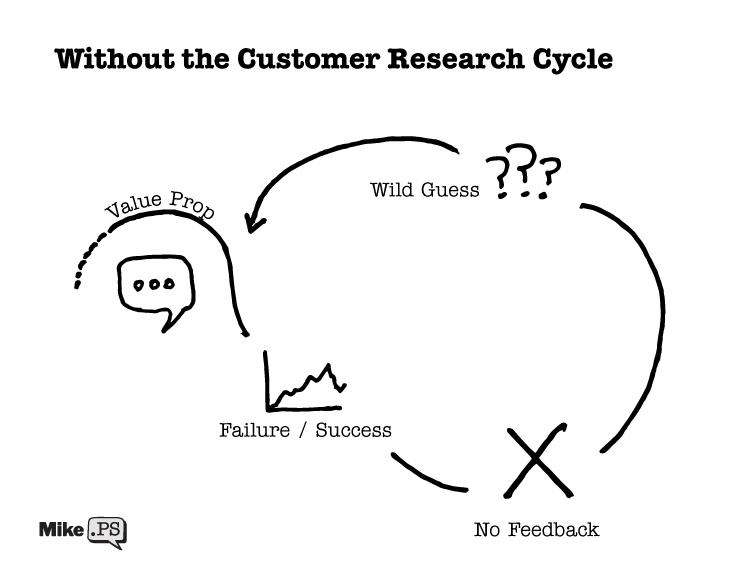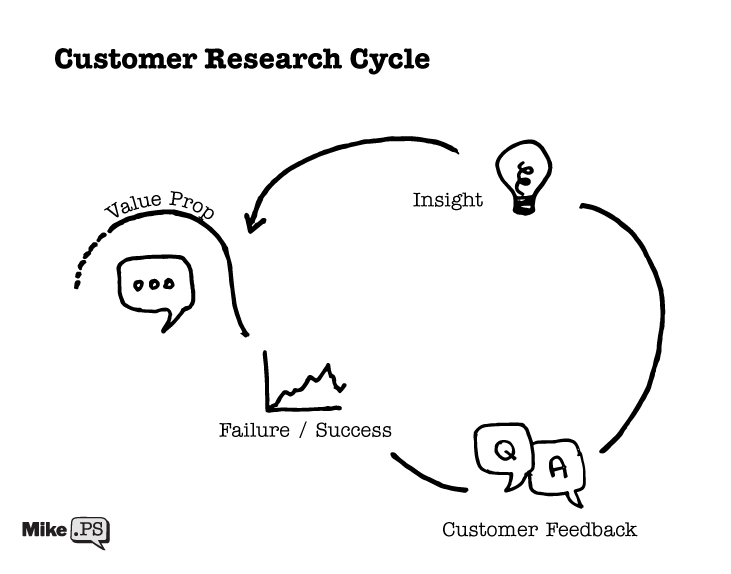In this post, I'm going to show you how to use voice-of-customer research to dramatically increase your acquisition and onboarding efforts.
I'll also show you how the growth team at Automattic (WordPress) is currently using customer research to scale growth.
I know this strategy works because it is the same strategy I have used to more than 2x revenue for multiple companies as a conversion optimization consultant and later multiply the revenue of the tech startups I joined many times over.
I recently attended the SaaS track for a growth conference where Kristina Quinones, who heads up growth at Automattic, gave an excellent overview of how customer research works and how to supercharge your acquisition efforts with it.
She did such a great job giving an overview of something that is so core to my own philosophy toward growth that I'd like to share some of those insights along with my own take on voice-of-customer-driven research.
The strategy of habitually and systematically using customer research to fuel growth is at the heart of every growth and customer-focused organization and is the closest thing to a magic bullet that I've ever found.
Let's get into it.
What is Voice-of-Customer Research?
Voice-of-customer (VOC) a process for discovering and understanding the wants and needs of customers. These insights can be used to directly improve acquisition and product retention efforts.
Voice-of-customer research is completed by surveying customers and listening to their feedback and sentiment. Done right, it leads to valuable insights into prospects' behavior, attitudes, and perceptions that you can use to improve your products and content.
Today's SaaS customers are extremely savvy. You would never throw a bunch of generic stock photos on your website and call it a day.
Similarly, you can't just write copy without customer research and expect it to resonate with customers.
Before writing copy and building content, you have to find out what customers are already saying about your product.
The basic building block of any growth initiative is an understanding of the customer and the customer's "jobs to be done." If you can translate those "jobs to be done" into value propositions that your target audience truly understands you will create a buying signal directly in the mind of the customer.

The most successful, high-growth companies weave their customer's very own words into their copy and use continual feedback to shape their entire product. However, most companies fail to do this.
Scaling marketing and sales without incorporating a customer research cycle leaves a lot of money on the table. You just don't have an effective feedback mechanism to continually hone in on the best messaging and growth ideas.

However, with a good customer research cycle, you can continually hone your growth initiatives around the customer. The customer will give you the exact words and phrases to use to unlock revenue and melt away objections. It can inform your sales team's presentations and show them what features to focus on. It can guide your onboarding and allow it to frame each step in terms of the end result the customer wants to have and feel.

Customer research allows you to speak your customer's language when talking about their pain and passion points. The reason why most companies fail to adopt a customer-driven growth strategy is that the customer research cycle is simple to implement but difficult to sustain.
Or said another way it's difficult to maintain feedback loops with your customers.
How to Build Feedback Loops
Strive to build a culture of feedback by building and maintaining feedback loops. Ways to do this include:
- NPS surveys with open-ended questions.
- Continual A/B testing.
- Heuristic testing with live narration from customers.
- Focus groups.
- Etc.
There are a ton of ways to do this.
The most important thing is to:
- Keep it simple.
- Focus on just one specific action.
- Only look at data related to driving that specific action.
"Not everything that can be counted counts, and not everything that counts can be counted."
Albert Einstein
Define a Clear Purpose
To keep it focused define a clear purpose and refer to it when planning, implementing or analyzing customer research.
Without the constraints of a clear purpose, you will experience scope creep, analysis paralysis, and your data will be too broad to be actionable.
Example of a vague purpose: The purpose of this feedback program is to learn more about our customers to increase sales.
Example of a clear purpose: The purpose of this feedback program is to uncover trends in customer sentiment, habits and expectations to more efficiently iterate on our messaging and other customer communications.
Ask a Focused Question
Now that you have a clear purpose, you want to further narrow your focus by asking a specific question you would like to answer.
For example:
- What words and phrases do customers use to describe their experience with our brand?
- What are our top opportunities for delivering a more cohesive experience?
- Where are customers themselves sighting gaps in their experience with their onboarding, sales process or support experience?
- Where are the gaps between the customer's initial product experience and our ability to communicate clearly and deliver value quickly?
If you don't know what questions to ask, spend some time in the data. Pretty soon you'll start asking yourself some pretty good questions like:
- Why are so many customers in a particular cohort churning while the others aren't?
- Why are customers falling off at a particular point in their onboarding?
Time with the data always prompts questions, which eventually leads to answers, which prompts still more questions.
If you're still not sure, towards the end, I'll show you a simple example survey that the growth team at Automattic uses as well as a slightly more in-depth survey I have used at my own past startups.
What Questions to Include in Your Survey
When in doubt keep it simple. A formula for a good survey would include:
- Experience rating (like NPS or CSAT.)
- Self-categorization (Like their role or industry.)
- A few open-ended questions that will give you insight into the outcomes customers desire or have achieved using your product.
- Questions shouldn't take the average customer longer than 5 minutes to fill out.
Because we're focused on acquisition in this particular post, we are going to ask questions about the outcomes customers want to achieve with your product. So you don't need to ask hyper-specific questions about your product or features.
Good acquisition questions help you highlight your customers':
- Emotional response.
- Perceived successes and failures that come as a result of using your product.
How Many Responses Do You Need?
The recommended minimum will be based on your current active customer volume.
The goal is to have enough responses that you can be reasonably sure they are representative of the cohort of customers you are analyzing.
You can use my sample size calculator to calculate the appropriate sample size.
Incentivization
The bigger the ask, the more likely you will need to incentivize customers to participate in your study.
Rule of thumb: If the survey includes more than 5-7 questions and takes more than 5-7 minutes to complete you may need an incentive like a gift card or a raffle.
If you're starting out keep your survey under that threshold to keep it simple.
Keeping it simple has a lot of benefits. Simplicity helps to:
- Improve organizational adoption.
- Facilitate clarity of purpose.
- Improve likelihood of data validitiy.
Steps to Launch a Customer Research Campaign
1 Plan It
Summarize what you are hoping to find out.
Define your audience.
Outline how you plan on applying the resulting insights.
2 Draft Your Study Components
Write your survey questions.
Define your hypothesis.
Prepare user-facing communications like the email invitation.
3 Ship It
There are a lot of good options for gathering insights.
- Proudsignal.
- Hotjar.
- Typeform.
- Google forms.
Just choose one and get going.
4 Analyze It
Once you hit your target number of responses it's time to analyze them.
Segment the results into pre-determined structured data categories (like CSAT score, the plan they are on, industry, or enriched data points from a tool like Clearbit) and into patterns that arise organically from the unstructured data (like common end goals, emotions, frustrations, and word clouds.)
The result can lead you to one of 2 things:
- Implement changes immediately.
- Do more digging.
5 Present Results
This is the most important step!
You have to highlight key takeaways including immediate, intermediate and long-term opportunities, and then feed those insights back into your acquisition strategy.
You will want to hone in on 2 things:
- Pain points that can be solved or mitigated through clarified communications.
- Passion points that customers reveal through their choice of words.
Passion points = those magical little aha moments that drive interest, consideration, purchase and activation.
- Kristina Quinones
Passion points are the pieces of the customer's experience that define their success and satisfaction with your product.
Take these insights and cross-reference them with your "jobs to be done" and compare them with your stated value propositions.
- Where is the intersection (or is there one at all)?
- What are your opportunities?
- This is as close as you'll ever find to a magic bullet.
Bottled Magic
I just want to reiterate how important it is to use your customer's own words. This is ultimately what voice-of-customer research is all about. How you phrase something and how your customer phrases something may sound essentially the same to you and me. But they are worlds apart for the customer.
You need to gather as many of these pain points and passion points in the customer's own words as you can so you can mirror the language used and successes described in your content.

Communication is the transference of ideas. Yet the human brain rejects over 99.9% of the ideas that are thrust upon it.
This is a survival mechanism. There is just no way your brain could function if it was persuaded to act on every ad, pitch, or request that it saw.
If you want to cut through the noise, decrease ad spend, increase conversion, and have an advantage over your competitors, you need to feed your customers their own words. It's not enough to convey the right idea. You need to convey it in their own words.
Example Voice-of-Customer Survey from Automattic
At Growthhackers Conference 2021, Kirstina Quinones shared a realworld example of a survey they recently used at Automattic.
"A recent user research survey uncovered some juicy info that challenged some of our assumptions about our customers."
Kristina Quinones, Director Growth Marketing @ Automattic
Cohort
In the survey, they targeted a fairly broad sweep of users across a couple of plan tiers but limited it to those who had been customers for 6-12 months.
Kirstina explained that this group is interesting because they have been customers long enough to be past the active consideration phase but not so long that they have forgotten their initial experience or why they chose WordPress.
Survey
Their survey included 3 basic components:
- A CSAT score: On a scale of 1 to 10, how would you rate your WordPress.com experience?
- Self-categorization from a predetermined list: How would you primarily classify your website?
- Call for open-ended feedback (open-ended questions.)
The open-ended questions included:
- Can you tell us a little more about why you chose the rating number?
- What has been your biggest challenge while using WordPress.com?
- What has been the best part of using WordPress.com?
- For those who self-categorized as bloggers:
- What do you find to be the most challenging part of your blogging experience?
- What part of blogging excites you the most?
Analysis
After collecting the survey data, Automattic's analysis included:
- Combine self-categorization along with user activity data.
- Segment data into cohorts.
- Calculate CSAT score.
- Word and phrase frequency.
- Collate data.
- Form additional hypotheses.
Validation
A great way to validate your findings before fully implementing them across the board is to run a small paid experiment.
Automattic runs social media ad campaigns to measure the potential or extrapolated lift as well as audience response and sentiment associated with any new messaging.
It can be interesting to see how this varies by geographical location.
Rinse and Repeat
Automattic's survey was an ad-hoc effort that will be repeated to a similarly defined cohort in 6 months.
They will compare and contrast the results and identify new opportunities for improvement and tests to run such as:
- New social media ad campaigns.
- New SEM experiments.
- Changes to onboarding.
With a few tweaks, this type of feedback outreach can be put on autopilot as customers pass a time or activity-based milestone.
Conclusion
I hope you enjoyed this post on customer-focused acquisition. Remember, the feedback and insights mean nothing unless you are prepared to advocate for change.
Also, remember that customer feedback loops can be difficult to maintain. Before each round of feedback ends you should already have your next research project on the docket, ready to be planned, built, and shipped.
If you can mirror your customer's unique language to reflect back to them their desired outcomes and personal aspirations you will supercharge your growth.
Communicating this way precludes objections because it reduces the cognitive load required for customers to understand how your product provides value. It's like jacking them directly into the Matrix.

